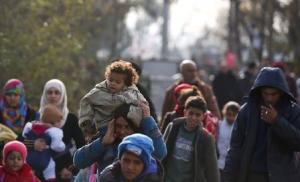Date: Fri, 11 Dec 2015 16:00:54 +0100

By Laurie Goering
PARIS (Thomson Reuters Foundation) - As weather extremes strengthen and seas rise around the world, forced migration linked to climate pressures is poised to become a “mega-problem” that could dwarf existing flows of conflict refugees, migration experts warned on Thursday.
"We’re way behind in protection and assistance to this group that we haven’t even recognized the size of,” said Jan Egeland, secretary-general of the Norwegian Refugee Council, speaking on the sidelines of the U.N. climate negotiations.
Last year, 11 million people fled conflict or violence in Syria, Afghanistan and other troubled regions of the world, he said. But the average number of people displaced by natural disasters, including floods, storms and droughts, has averaged 22.5 million a year since 2008 and is growing, he said.
At the Paris talks, aiming to seal a deal to address climate change this week, “it's important to recognize in a legally binding document that this is a mega-problem”, Egeland said.
As of Thursday, the draft climate deal did, for the first time, mention the need to protect migrants fleeing climate pressures, said William Lacy Swing, director general of the International Organization for Migration.
That is crucial because “no one can expect to live in peace if we let extreme poverty be exacerbated by the climate crisis”, said Nicholas Hulot, a special envoy of the French president.
In places from the island nation of Tuvalu, hit by storm surges, to the Sahel's drought-prone Burkina Faso, “for many men, women and children, the disaster is right here and now”, he said.
Low-lying Bangladesh could see a 15 percent increase in net poverty by 2030 as a result of climate pressures, including flooding, storm surges, erosion and salt intrusion in drinking water and farmland, said Kamal Uddin Ahmed, secretary of the country's Ministry of Environment and Forests.
The crowded country of 156 million could also eventually lose a sixth of its territory if a warming world leads to 1 meter of sea-level rise - likely before the turn of the century at the current rate of climate change, scientists say.
Such losses could mean “we need to think of ways to uphold displaced peoples' right to survive”, Uddin Ahmed said. That could include migration, he added.
Monique Barbut, executive secretary of the U.N. Convention to Combat Desertification, said people under pressure from creeping deserts and drought are increasingly relocating - not just temporarily but permanently.
“People are making the only rational choice, to move as a coping mechanism,” she said.
In Mexico, at least 600,000 people each year move permanently from dry areas to other parts of the country, or across international borders, she said.
In North Africa and the Middle East, some of the major drivers of migration “are now deeply rooted in the depletion of natural resources, as well as aspiration for a better economic future”, she said.
Africa’s Sahel region is particularly at risk of a migration surge, Barbut said.
About 80 percent of people depend on farming, herding, fishing or other jobs connected to the land, and population is rising fast, at about 3 percent a year, even as temperatures increase and rainfall becomes hugely more uncertain.
SKILLS & IDEAS
Helping people find ways to stay, rather than migrate, will require spending money both to limit climate change impacts, and to help the poor find ways to cope with changes that are already inevitable, said Alfredo Zamudio, head of the Internal Displacement Monitoring Centre of the Norwegian Refugee Council.
“Displacement can be prevented, can be minimized, by increased investment in (climate change) mitigation and adaptation measures,” he said. “This is a time for action.”
His agency is collecting data on displacement in 173 countries around the world, to better understand the trends.
Some level of increase in climate-related migration is now inevitable, and countries should start planning for it, said Michelle Leighton, chief of labor migration at the International Labour Organisation.
Measures should include smoothing the way for migrants to gain skills and find jobs in their new regions and countries, she said.
“These are people who bring skills and talents and ideas that can help fill labor shortages, of which there are many,” she said.
Making it possible for them to find jobs is crucial, she said, because “without regular pathways, migrants are going into the informal economy, and this doesn’t help societies”.
Migrants who struggle to find work can end up going to recruiting agencies that take a big share of their income, and are at much higher risk of trafficking, she said.
Volker Turk, a refugee protection expert at the U.N. Refugee Agency (UNHCR), said he hoped the new global climate deal, now in its final days of negotiation in Paris, would give human mobility “the attention it deserves”.
“If the reality is not accepted and dealt with... we see a whole host of consequences,” he warned.
(Reporting by Laurie Goering; editing by Megan Rowling; Please credit the Thomson Reuters Foundation, the charitable arm of Thomson Reuters, that covers humanitarian news, climate change, women's rights, trafficking and corruption. Visit www.trust.org/climate)